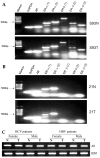The expression of estrogen receptors in hepatocellular carcinoma in Korean patients
- PMID: 17191310
- PMCID: PMC2687821
- DOI: 10.3349/ymj.2006.47.6.811
The expression of estrogen receptors in hepatocellular carcinoma in Korean patients
Abstract
Expression of estrogen receptors (ER)-alpha and -beta, as well as androgen receptor (AR), in hepatocellular carcinoma (HCC) is thought to be correlated with prognosis, survival, and male prevalence of HCC. These hypotheses are based on investigations of European patients; however the expression patterns of these receptors in Asian patients are largely unknown. In this study, we collected liver carcinoma and peritumor tissues from 32 patients (9 females and 23 males) in South Korea. The expression of ERs and ARs was studied using RT-PCR. Wild-type ER-alpha and AR were expressed in all of the samples investigated, and their expression was independent of the causal virus or patient sex. Expression of the ER-alpha variant was independent of sex (100% female vs. 91.3% male) and HCV and HBV status (91.3% vs. 100%). Wild-type ER-beta was expressed more often in HCV patients than in HBV patients (95.7% vs. 44.4%; p < 0.05). In conclusion, the stronger ER-alpha variant expression in HCC tissues implies that this variant has an important role in HCC development. However, at least in Korean patients, expression of the ER-alpha variant (vER-alpha) is not related to male HCC prevalence. In addition, the predominant expression of ER-beta in HCV patients suggests that it plays an important role in HCV-induced liver disease.
Figures


Similar articles
-
The clinical and pathogenetic significance of estrogen receptor-beta expression in chronic liver diseases and liver carcinoma.Cancer. 2003 Aug 1;98(3):529-34. doi: 10.1002/cncr.11528. Cancer. 2003. PMID: 12879470
-
[Correlation between androgen receptor expression and hepatitis B virus X protein and its clinical significance in hepatocellular carcinoma].Zhonghua Zhong Liu Za Zhi. 2013 Apr;35(4):282-7. doi: 10.3760/cma.j.issn.0253-3766.2013.04.009. Zhonghua Zhong Liu Za Zhi. 2013. PMID: 23985257 Chinese.
-
Estrogen receptor expression in chronic hepatitis C and hepatocellular carcinoma pathogenesis.World J Gastroenterol. 2017 Oct 7;23(37):6802-6816. doi: 10.3748/wjg.v23.i37.6802. World J Gastroenterol. 2017. PMID: 29085224 Free PMC article.
-
Role of sex steroid receptors in pathobiology of hepatocellular carcinoma.World J Gastroenterol. 2008 Oct 21;14(39):5945-61. doi: 10.3748/wjg.14.5945. World J Gastroenterol. 2008. PMID: 18932272 Free PMC article. Review.
-
[Current status and clinical course of hepatitis C virus in Korea].Korean J Gastroenterol. 2008 Jun;51(6):360-7. Korean J Gastroenterol. 2008. PMID: 18604137 Review. Korean.
Cited by
-
Role of estrogen receptors in health and disease.Front Endocrinol (Lausanne). 2022 Aug 18;13:839005. doi: 10.3389/fendo.2022.839005. eCollection 2022. Front Endocrinol (Lausanne). 2022. PMID: 36060947 Free PMC article. Review.
-
Hepatic androgen receptor suppresses hepatocellular carcinoma metastasis through modulation of cell migration and anoikis.Hepatology. 2012 Jul;56(1):176-85. doi: 10.1002/hep.25644. Epub 2012 Jun 5. Hepatology. 2012. PMID: 22318717 Free PMC article.
-
Non-coding RNA-associated competitive endogenous RNA regulatory networks: Novel diagnostic and therapeutic opportunities for hepatocellular carcinoma.J Cell Mol Med. 2022 Jan;26(2):287-305. doi: 10.1111/jcmm.17126. Epub 2021 Dec 14. J Cell Mol Med. 2022. PMID: 34907642 Free PMC article. Review.
-
Role of estrogen in hepatocellular carcinoma: is inflammation the key?J Transl Med. 2014 Apr 8;12:93. doi: 10.1186/1479-5876-12-93. J Transl Med. 2014. PMID: 24708807 Free PMC article. Review.
-
Role of sex hormones in the modulation of cholangiocyte function.World J Gastrointest Pathophysiol. 2010 Jun 15;1(2):50-62. doi: 10.4291/wjgp.v1.i2.50. World J Gastrointest Pathophysiol. 2010. PMID: 21607142 Free PMC article.
References
-
- Yang WI, Choi IJ, Kim HO, Lee KS. Demonstration of estrogen receptor by immunohistochemical staining in paraffin sections of breast carcinoma. Yonsei Med J. 1991;32:117–125. - PubMed
-
- Eagon PK, Porter LE, Francavilla A, DiLeo A, Van Thiel DH. Estrogen and androgen receptors in liver: their role in liver disease and regeneration. Semin Liver Dis. 1985;5:59–69. - PubMed
-
- Johnson PJ. Sex hormones and the liver. Clin Sci (Lond) 1984;66:369–376. - PubMed
-
- Nagasue N, Ito A, Yukaya H, Ogawa Y. Androgen receptors in hepatocellular carcinoma and surrounding parenchyma. Gastroenterology. 1985;89:643–647. - PubMed
-
- Roy AK, Milin BS, McMinn DM. Androgen receptor in rat liver: hormonal and developmental regulation of the cytoplasmic receptor and its correlation with the androgen-dependent synthesis of alpha2u-globulin. Biochim Biophys Acta. 1974;354:213–232. - PubMed
Publication types
MeSH terms
Substances
LinkOut - more resources
Full Text Sources
Medical
Research Materials

